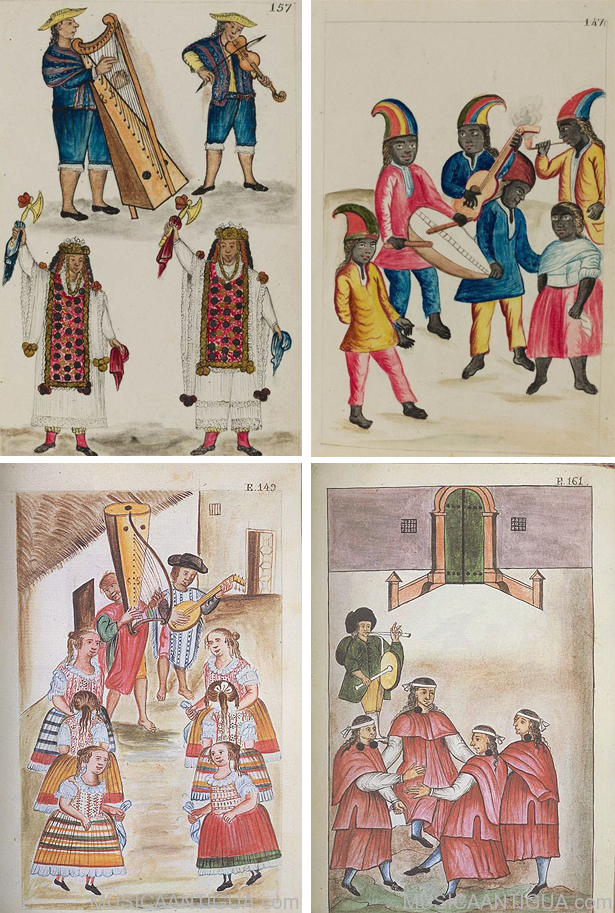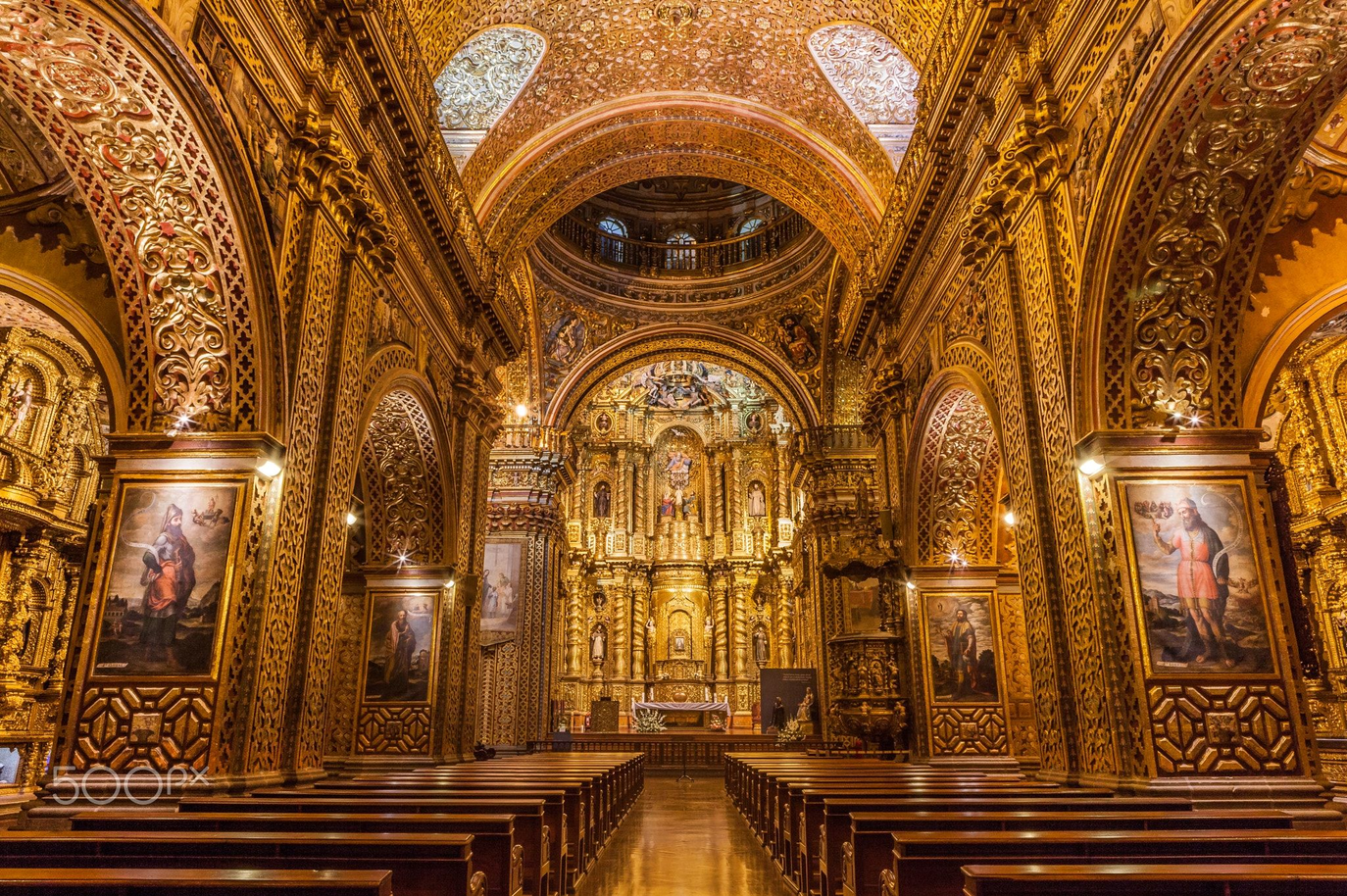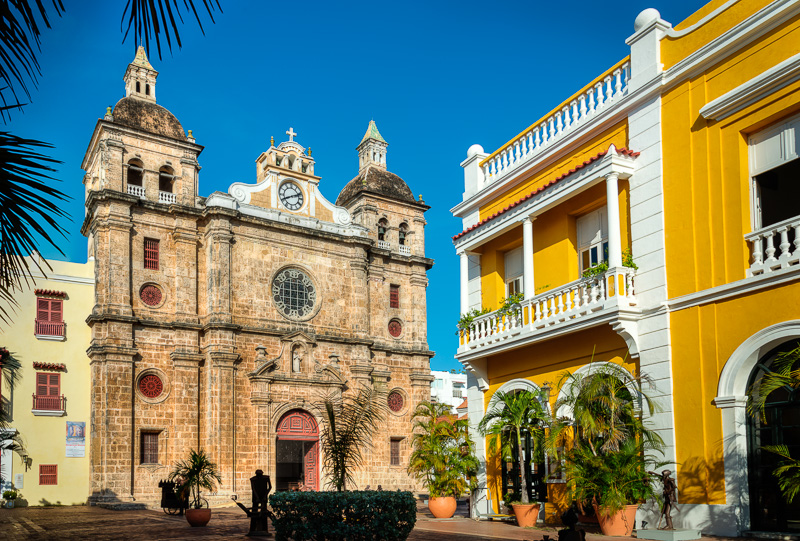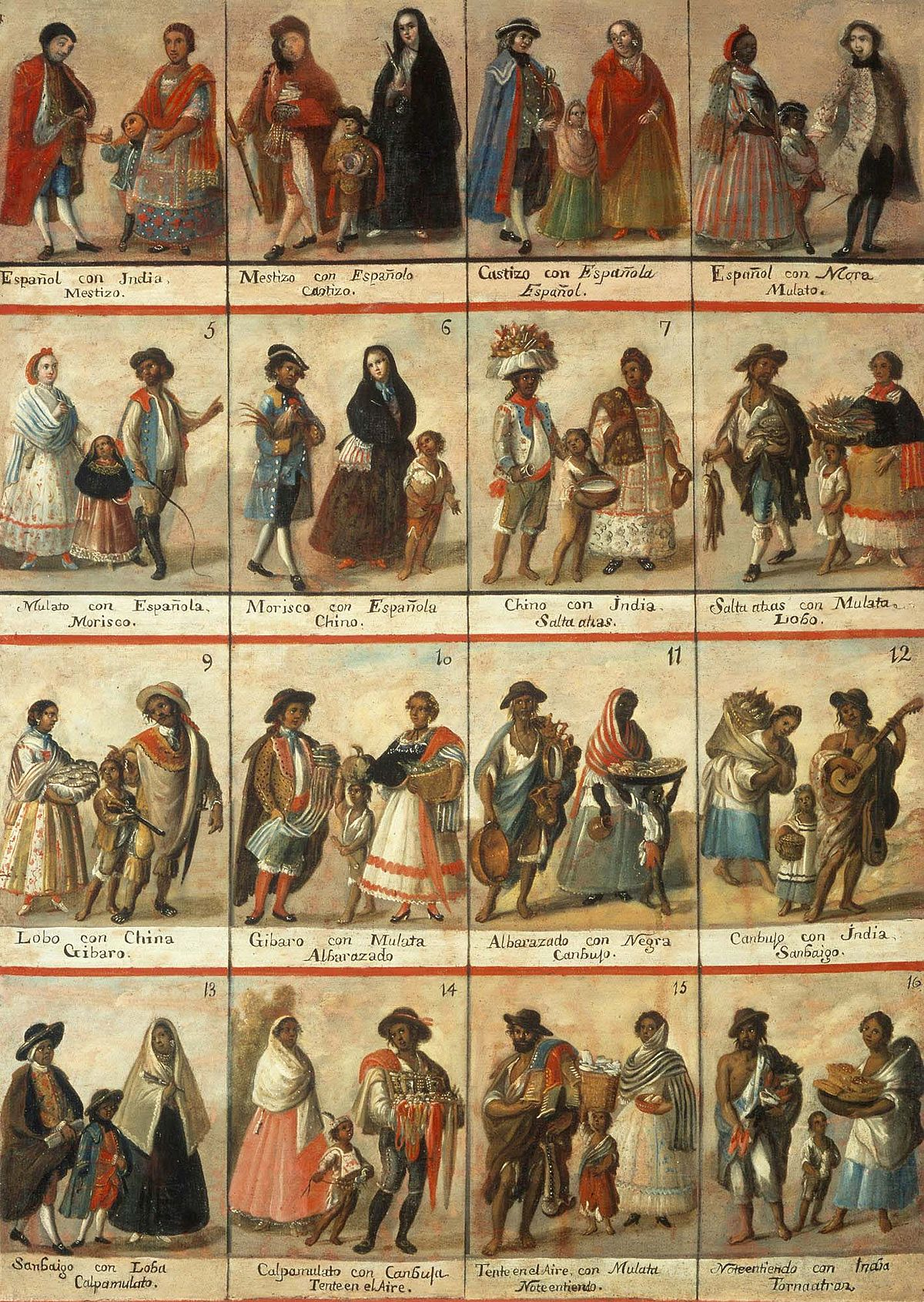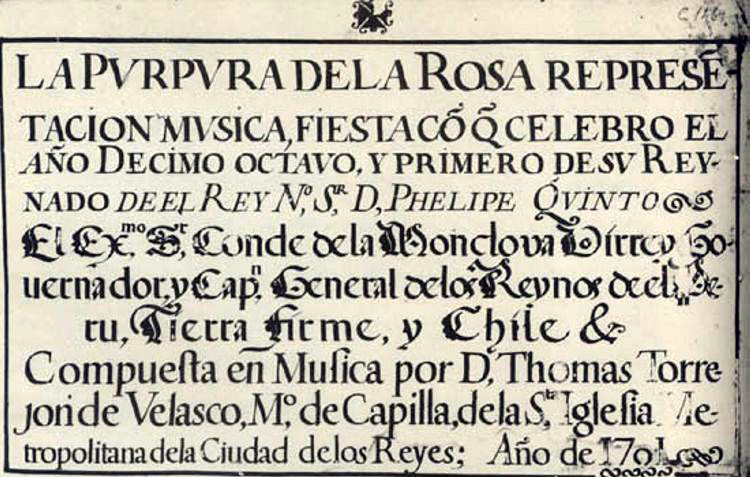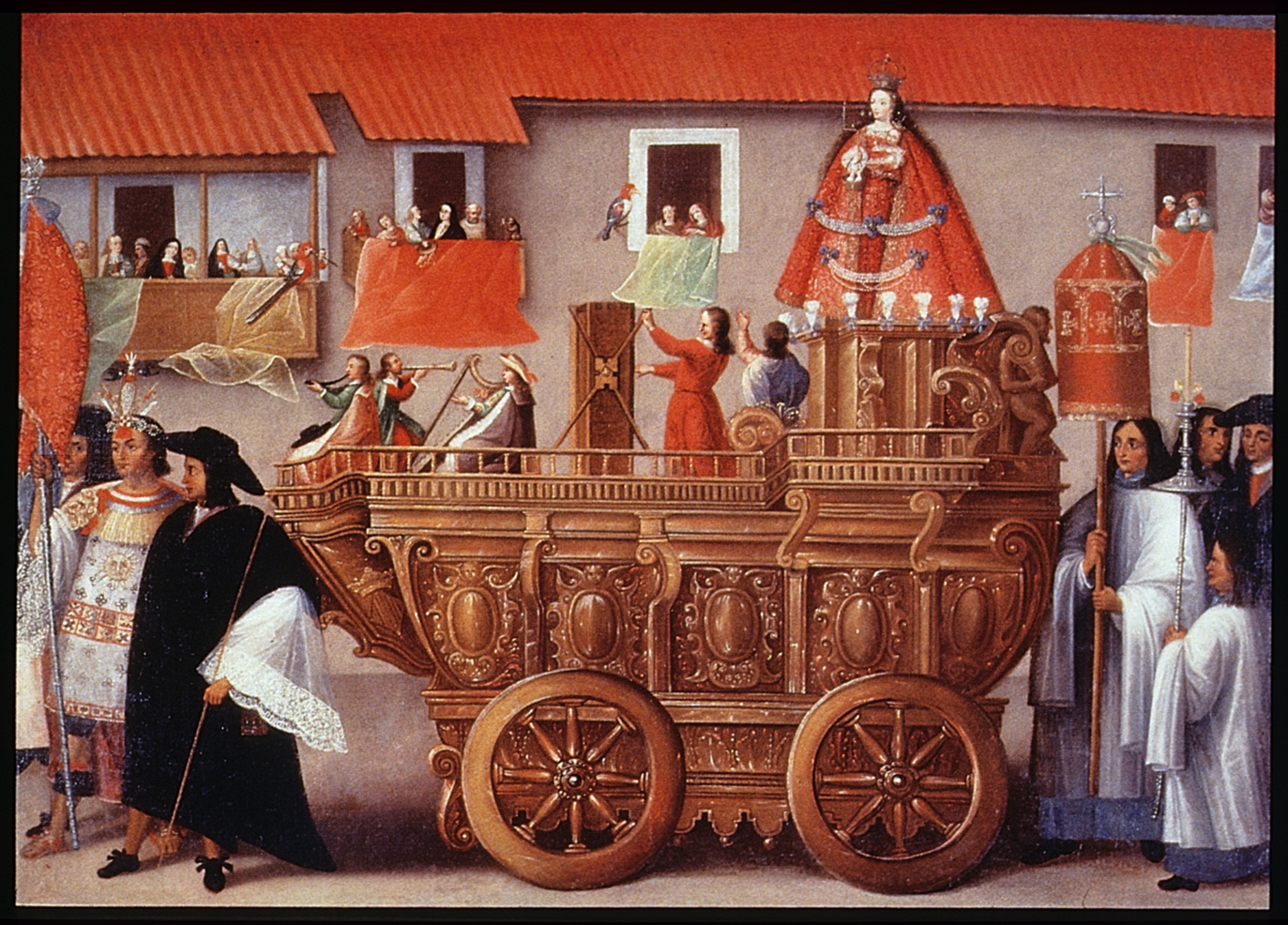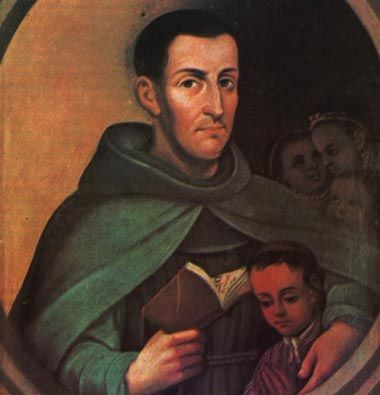Chapter three.
The new American courts and missions: centres of power, centres of culture
“In several reductions there are, nowadays, Indian masters who know how to make of the vibrant cedar wood a harp of David [...]”
Antonio Sepp, Continuación de las labores Apostolicas, (Buenos Aires: Eudeba, 1973), vol. 2, p. 137.
At least three main scenarios should be identified when referring to the cultural life of the American colonies south of California, including Central America and the West Indies, as well as most of the South American continent, and in particular to the loci (from Latin places) of colonial music: the baroque cathedrals, the missions, and the court palaces.
The existing literature on colonial music in America is relatively abundant as to the sources of religious music in the capitals of the Spanish Empire and in the outposts of penetration of Catholic religious culture in America, the religious missions aimed at the evangelization of the native Americans.1 When the present research was designed, it seemed logical to develop a line of investigation also in the direction of secular music which certainly had to exist in those societies that were gradually defining themselves as true vice royal courts in the Spanish overseas domains. As we observed in the previous chapter, there are clear signs that the Spanish courts of the new world had an advanced and prosperous cultural life, with elements that progressively assumed a specific identity, autonomous from its Spanish origin. The American paintings of the colonies, as well as the exuberant baroque architecture and decoration, are clear examples of the cultural vivacity of the New World Spaniard society, as we briefly mentioned it in the previous chapters of this study.
Apparently, however, access to the direct sources related to courtly life in the New World is particularly difficult to access compared to the documentation available on the religious life and culture. In essence, there is a general lack of studies on the secular music in the colony, as the result of a reduced corpus of original documents that could be partly due to a certain reticence that was typical of the Spanish government in America in leaving the sources of government recorded. It was a tendency of imperial Spain for a long time, perhaps even until the dissolution of the empire and the conquest of the independence of the overseas lands, that the Spanish government maintained a system of strong cultural closure with respect to the entry and exit of information relating to the government of the colonial territories. This was probably largely due to the fear that other countries and cultures might have more information about Spain's American domains and, to an equal extent, to the fear that new enlightened ideas might in some way question the Spanish system of government in its colonies. It is a fact that, from our point of view, one must assume the existence of a rich and advanced secular music, somehow comparable in complexity and originality to the other forms of cultural expression of the colony, but the access to direct information about these sources proven to be an insurmountable task, at least through the electronic information system available in the net.
1 Refer, for example, among others, to the Código Martinez Compañon, the Codex Zuola, the music preserved in the Musical Archive of Chiquitos (Santa Ana y San Rafael de Chiquitos, Bolivia) and in the Archive of the Cathedral of Puebla (Mexico).
Considering the capacity of the outpost music, and in a certain measure also of the formal liturgic music, to incorporate elements of the native cultures, it is evident that the secular music, less tied to rigid patterns of style and representation, must have enjoyed greater freedom for this incorporation — both at organological and stylistic levels —, thus contributing at defining in a sharper form its own autonomous characteristics. We still hope that new, unpublished documents could shed light on the non-religious music of the American colonies, but this will probably require a direct analysis of the sources on site, through direct visits and searches in the archives of the great capitals of the Spanish empire; this goes beyond the purposes set out for this study.
Music in the American cathedrals
The very opulence of the American metropolitan cathedrals must be interpreted not only as an effort by the Catholic Church to show its religious and secular power to the new American societies but also as a political show of power and a symbol of the economic competition between the different cities of the American colonies. The tender for the construction of the most beautiful catholic temples in the New World was probably a phenomenon analogous to that already happened in the European capitals of the Middle Ages and the Renaissance period, when the aristocratic families that governed the different centres of power in Europe competed, among other things, also in the magnificence, richness and beauty of the cathedrals built in their domains.
In the first fifty years after Columbus' finding of the overseas territories, ten architectonical relevant Spanish cathedrals had already been built in Santo Domingo, Panama, Jamaica, Cuba, Mexico, Nicaragua, Honduras, Peru, and Ecuador.
The extraordinary flowering of the colonial Baroque style, with its hyper-decorative models where all the available space was filled with ornaments, is a clear testimony of an interest that transcended those strictly religious. The sumptuous and extensive decorations in pure gold of the Quito cathedral cannot be interpreted exclusively as an attempt to exalt the love for God, but also as a bold statement about the wealth and power of the new dominant classes.
But the splendour of the great houses of the Christian God in the New World could not be limited to the grandeur of architecture, the harmony of proportions, the nobility of materials or the sophisticated, hyperbolic exuberance of decorative elements. American cathedrals had to resound with heavenly music.
The incorporation of the “cultured” musical components into the liturgical system and, more generally, into the representative pomp of religious activities and ecclesiastical ceremonies, was not an immediate process. For a few decades, colonial cathedrals had to settle for a mixture of musical “intentions” of European origin and performances carried out by criollo apprentices, sometimes in a substantial measure. It was only thirty-five years after the Colombian “discovery” that the spiritual power of the colony — and probably also the temporal one — could justify the need and find the resources to contract trained clergy musicians from the mother country. Juan de Alcalá was, in 1530, the first official organist appointed in the American continent, where he served in the Mexico cathedral. In 1537, the maestro de capilla Juan Pérez Materano (?–1561) was appointed by the Spanish court to occupy the position of director of the choir of the cathedral of Mexico, the capital of the kingdom of Nueva España. Passing through Cartagena de las Indias along his itinerary, he was convinced by the Cabildo of the city to stay there as a musician. His place in Mexico was taken in 1538 by the precentor Cristobal de Pedraza, who travelled from Seville with eight priests to serve in the choir of the cathedral.2 As to Pérez Materano, after becoming a cleric and eventually, since 1554, dean of the metropolitan cathedral of Cartagena, he never left Nueva Granada, where he died in 1561.3 In 1554 he was the author of the Libro de canto de órgano y canto llano4 — probably the first theoretic book of music written in American soil —, to which a cedula regia5 granted a licence to be published in 1599.
2 Tess Knighton (ed.), Companion to Music in the Age of the Catholic Monarchs, Leiden: Brill, 2016, p. 350.
3 Juan Friede, “El primer libro colombiano,” Boletín Cultural y Bibliográfico vol. 4, no. 12 (1961), p. 1181.
4 Juan Pérez Materano, Libro de canto de órgano y canto llano (1554), Catedral de Cartagena de Indias, Colombia, cited in María Gembero-Ustárroz, “Pérez Materano, Juan”, Books of Hispanic Polyphony, ed. E. Ros-Fábregas, CSIC, Institució Milà i Fontanals, Barcelona.
5 "Real cédula otorgando a don Juan Pérez Materano, deán de la iglesia Catedral de la ciudad de Cartagena de Indias, el derecho exclusivo [...]". Valladolid August 11, 1557, Archivo General de Indias.
The establishment of a real music chapel is also late in the process. The actas de erección, at least until 1622,6 contemplated, as only musical places, those of the chantre7 and the organist.8 It is very likely that this fact was due, at least in part, to the lack of funds available to the cathedrals, which were forced, when their incomes were too low, to rely on the dos novenos reales loaned by the king9 or to the capellanías, sums of money that the devotees granted to religious institutions, in exchange for masses celebrated in their memory. It was thanks to the latter in particular that cathedrals could afford to pay singers and musicians, thus expanding what would become the cathedrals' musical chapels.10
The new-born musical chapels of the New World were composed of singers of all ages and vocal registers (low-pitched voices were much sought after, as they were uncommon among the natives) and of musicians of all sorts of instruments — harpists, organists, cornetists, dulcian players. All of them, with the exception of the organists, were part of the so-called ministriles, groups of musicians already existing in the old world, contracted by religious institutions to complete the instrumental staff during religious celebrations. The main characteristic of the ministriles of both the old and the new world was the social — and ethnic — differentiation, as far as Latin America is concerned, with respect to the religious members of the musical chapels: the musicians tended to be of low social extraction and, in Latin America, they were, moreover, natives, negroes and mulattos.11
It was only in the early XVIII century that the musical chapels themselves began to function, made up of 30/40 members including violinists, violone players, double bassists, harpists, flutists and trumpeters. The transition from the ministriles groups of the previous century had already started in early 1701 when Father Anton Sepp, a German Jesuit, introduced the teaching of the violin, thus expanding the musical and stylistic possibilities of the cathedral and missionary musical chapels.12
6 The only exception is the cathedral of Buenos Aires (1622), probably because of the construction later in time than the first "wave" of Latin-American cathedrals.
7 "Ancestor" of the maestro di cappella, responsible for the composition of songs for religious liturgies and in charge of musical teaching.
8 Alejandro Vera Aguilera, "Música en Hispanoamérica durante el siglo XVII", in Historia de la música en España e Hispanoamérica - La música en el siglo XVII, vol. 3, 8 vols. (Madrid: Fondo de Cultura Económica, 2016), o. 645.
9 With the institution of the royal patronage, the king had the right to appoint the main charges of the cathedrals and to collect a part of the rents of the cathedral itself, the two royal ninths (the entire amount of the rents was divided in half: a fourth ended up in the hands of the bishop and the other in those of the ecclesiastical chapter; the rest was divided into nine parts, two of which were destined for the Crown).
10 Vera Aguilera A., "Música en Hispanoamérica durante el siglo XVII", op. cit., pp. 645-648.
11 The use of indigenous people inside the musical chapels was particularly in fashion given the savings that followed: many of these natives were yanaconas (they had to contribute free of charge with some services in order to be exempt from paying taxes).
12 Leonardo Waisman, "La música en la America Española", in Historia de la música en España e Hispanoamérica, vol. 4, 8 vols. (Madrid: Fondo de Cultura Económica, 2014), p. 560.
Music in the American courts and cities
Keeping in mind the premise made in the previous chapters, concerning the state of the arts in the old world, it seems logical to think that, upon their arrival in the new world, the Spanish authorities, but also the settlers of all social backgrounds, accustomed to such splendour, felt a deep nostalgia for the atmosphere — smells, natural and urban landscapes, sounds — of their native land. All this formed part of an identity that they tried at all costs to preserve on American soil, especially to distinguish themselves from an élite criolla that, with increasing insistence, tried to rise to the heights of viceroys and governors arriving from Spain. It is not strange, therefore, that many prominent personalities travelled with musicians and singers in their entourage, to be able to keep close the memory of the sounds heard in the motherland.
Unfortunately, it is almost impossible to trace the documentation of private homes because, unlike in the religious sphere, they were not obliged to account to anybody for their activities and their trade. There is little information about expeditions of nobles of which we are aware. We know, for example, of the Viceroy Count of Lemos who, on his journey to the New World in 1667, brought to his retinue Tomás de Torrejón y Velasco (chapel master of the cathedral of Lima since 1676), very well-known nowadays in the musical field thanks, among other things, to the numerous preserved villancicos, and Lucas Ruiz de Ribayaz, less known but interesting for this research, as will be seen later. However, almost no trace of the musical activity that took place in the great houses of the aristocracy remains. The Count of Lemos and his successor, the viceroy Count of Monclova, despite their being prominent figures in the Spanish-American world of the time, have not left any documentation that speaks of the important musical activity that was to take place at the time in their homes. Their name was passed on to posterity only thanks to Torrejón de Velasco (the Count of Lemos for having introduced him to the New World and the Count of Monclova for having commissioned the opera La Púrpura de la rosa, to a libretto by Calderón).
Unlike the XVI and XVII centuries, the XVIII century provides much more information about the musical environment other than the ecclesiastical one. In line with the new political idea, tending towards the European Enlightenment, there was an increase in the opportunities for participation in operas of the cultured theatre, on the other hand repressing the coloquios, small comedies with music at the end of which dances were performed, since they were the activities of the natives and the castas.13
As previously mentioned, the century opened with the premiere of La púrpura de la rosa, in the viceroy palace of Lima in 1701, followed by El mejor escudo de Perseo (1708) and La Partenope by Manuel de Sumaya (1711).14 The world of theatre thus began to take its place within colonial society, especially in its function of moral and civic education,15 and to endeavour to improve the quality of the show, by calling famous actors, singers and musicians from Spain16 (although the best of them tended to switch to the musical chapels, attracted by better working conditions).
The significant growth of semi-public opportunities to make music, comparable to the European "living rooms", also dates back to this period.17 According to historical sources, the best evenings were those offered by the viceroys of New Spain and Peru in their respective palaces, where the best musicians of the city were hired, including those of the cathedral's music chapel and the master of the chapel itself. But not only were the viceroy's palaces entertained by the best music, both European and local/autochthonous, of the time, but also the noble palaces and those of the upper-middle class. It is very likely, moreover, that "cultured" music was not limited only to the palaces of wealthy people, but that public meetings and evenings, in general, were accompanied by the sound of symphonies and chamber music of composers such as Boccherini, Clementi, Dittersdorf, Gossec, Haydn, Mozart,18 although, unfortunately, we have no sources to confirm it.
13 This enlightened mentality, imported from Europe, wanted to modernise and acculturate society, but at the same time, it ennobled the need for order and denigrated the festive idleness typical of the popular sectors (carnavales relegated to the suburbs, the jamaicas — popular dances performed in private houses — are forbidden by the viceroys).
14 Of none of these works, with the exception of the Púrpura de la rosa, the score has survived to the present day.
15 Due to its educational function, there are several regulations that regulate to the smallest detail the management and behaviour of comedians, musicians and the public.
16 “[…] Verás como es diferente
de este nuestro coliseo [de Mexico],
que toda la compañía
se compone de europeos.
Pues de España conducidos
sólo a costa de dinero,
reluce la habilidad,
resplandece el lucimiento.[…]”
Simon Ayanque, Lima Por Dentro y Por Fuera (Valladolid: Maxtor Editorial, 2012).
17 The concept of a public concert with entrance to be paid for had not yet been introduced, at least not in the Americas.
18 In 1801 a merchant from Mexico City had for sale symphonies of these composers, as well as chamber compositions of these and other composers, both European and neohispanic. Waisman L., “La música en la America española”, op. cit., p. 639.
Music in the outposts of the Catholicism
With the arrival of the conquistadors, and with them the first settlers, it became indispensable, among other things, the need to create an ecclesiastical system that emulated that of the distant motherland. Already the first expeditions, in fact, partly for this purpose and partly for the spiritual care of the settlers and soldiers, were accompanied by chaplains, charged with celebrating mass and bringing spiritual relief to those who had just left their homeland.
For the first time in the history of the Papacy, at this time of great territorial discoveries, the patronage law was introduced, which, in a heritage of the Arab world, tended towards the almost indissoluble unification of temporal and spiritual powers. The Kings, and by their hand also the conquerors, had the right, economic and political, on the new conquered lands, but they also had the duty of the "propagation of the Faith" among the newly discovered populations.19
An incredible need for evangelising fathers was therefore created since the above-mentioned chaplains were in a decidedly small number to be able to carry out this task also.20 Thus, as soon as the first news from the new lands reaches the old world, a small group of Franciscan fathers will ask Charles V, through Father de Gante (his close relative), to be able to go to the new world to take charge of the approach to the Christian faith of the indigenous peoples.
When they arrived in 1524, it became immediately clear that there was a need to get closer to the local culture, in order to fulfil the task of bringing the latter closer to that of the invaders, and what better method, if not to learn the language? The three Franciscans, after having learned the local language (the nahuatl), were granted the use of some spaces in the palaces of Texcoco (Mexico) where they opened the first European school in the new world, soon followed by that of San José de los Naturales (Mexico City).
19 Enrique Dussel, Historia de la iglesia en América Latina : medio milenio de coloniaje y liberación (1492-1992), 6th ed. (Madrid, Spain: Mundo Negro-Esquila Misional, 1967), http://bibliotecavirtual.clacso.org.ar/clacso/otros/20120215100901/iglesia.pdf, pp. 80-81.
20 Robert Stevenson, Music in Aztec & Inca Territory, (Berkeley and Los Angeles: University of California Press, 1968), p. 155.
21 From the fifth letter of Friar Pedro de Gante to King Philip II: Carta de Fr. Pedro de Gante al Rey D. Felipe II. De San Francisco de México junio 23 de 1558.
Emilio Ros-Fábregas, “‘Imagine All the People...’: Polyphonic Flowers in the Hands and Voices of Indians in 16th-Century Mexico,” Early Music, Vol. XL, no. 2 (May 2012), pp. 177-179.
Ernesto Torre Villar, “Fray Pedro de Gante, Maestro y Civilizador de America,” Estudios de Historia Novoispana, vol. 5, no. 5 (1974): 1-81,
http://dx.doi.org/10.22201/iih.24486922e.1974.005.3252, p. 4.
The method which Father de Gante employed in the evangelization of the natives, and then spread to the great majority of the missions of the New World, was based on the association, already existing in the populations of the entire territory of the New World, between music and religious rites, as de Gente himself explained in his letter of 1558 to Philip II.22 The work of the missionary was made easier, it was sufficient to write new texts (in the native language) to associate them with the melodies already in use so that the association of their music with the "old" divinities could be "broken", theoretically eradicating paganism in the process.
This approach proved so effective that even the Jesuits, since their arrival in the New World, adopted it within their native reducciones. Upon their arrival in the mid-1940s, the Real Cédula (1545) initiated the creation of indigenous communities — “administrative” units designed to simplify tax collection and to ensure concentrations of easily available manpower, but also to accelerate the process of physical control and acculturation of the newly subjugated populations. Christian preaching, and Christian songs, were powerful instruments in the hands of the Jesuits to create their own reducciones and to develop their own political, economic and cultural system. “Isolated populations” were more easily managed “so that their way of life may be removed from the vileness and meagre nature of their natural and ancient way of life; thus they will be taught how to be good spouses and know how to manage their estates and raise and marry their children”.23
Under the government of the reducciones by the Jesuits, American indigenous people learned how to become good Christians in a place where the laws and norms of the Catholic Church eventually prevailed. So vast and so powerful were these Jesuit reducciones, particularly that of Chiquitos and that of Moxos (or Mojos) — both in the territory of present-day Bolivia — that they managed to build an independent and self-sufficient state, where the natives could devote themselves to divine worship, crafts, agriculture and music, being as far away as possible from the “bad” influence of the Spanish settlers.
After the establishment of a church, the first task of the missionary in founding a new village, thanks also to the Synod of Trujillo in 1623, was to establish a school that would teach the children of the caciques,24 and other prominent figures and their children, to read and write in Latin, Spanish and the local language, as well as, of course, to play and sing.25
22 In Stevenson R., Music in Aztec & Inca Territory, op. cit., p. 92, the letter is dated June 23, 1557.
23 “[…] poblaciones distintas y apartadas, para que su modo de vivir sea muy fuera de la vileza y poquedad de su natural y antiguo modo de vivir; y así se les enseñarán cómo han de ser buenos casados y saber regir sus haciendas y criar y casar sus hijos […]”.
Manuel Ruiz, “Espíritu misional de la Compañía de Jesus,” in La misión y los jesuitas en la América española, 1566-1767: cambios y permanencias (Sevilla, Spain: CSIC. Consejo Superior de Investigaciones Científicas, 2005), p. 24. From Astrain, a Historia de la compañía de Jesus en la Asistencia de España, t. 2, Madrid 1905, pp. 144-145.
24 “[…] que haya escuela de canto y musica para el servicio y adorno de las iglesias […]
From Vera Aguilera A., “Música en Hispanoamérica durante el siglo XVII”, op. cit., p. 676.
25 Throughout the work of evangelisation of the New World, it can be see a close relationship between music and alphabetisation as both were considered, by the Spanish and the inhabitants of the Old World, as a symbol of "civilisation".
But for the grace of God I began to know them [Indians] and understand their condition and their value, and how they should be treated, since all their praise to their gods was to sing and dance in front of them, because when they had to sacrifice some victims for any given reason or to obtain victory from their enemies or temporal needs, before killing them they had to sing in front of their idol. And since I saw this and that all their songs were dedicated to their gods, I composed very solemn verses about God’s law, faith, how God was made man to save humanity, and how He was born from the Virgin Mary, remaining pure and undefiled. All this in more or less two months before the Nativity of Christ, and I also gave them cattle skins to paint as capes to dance in, as they used to do, since, fitting the dances and songs [cantares] they performed, they dressed in happy, mourning or victory attire. And then when Christmas was approaching, I called all the people from twenty miles around Mexico to come to the feast of the birth of Christ our Redeemer, and when they came there were so many people that they did not fit in the courtyard, although it is very large, and each province had made its own tent where they received the main people, and some came from seven or eight leagues away, sick people in hammocks, and others came from six and ten leagues away by water, and they listened on Christmas Eve to the angels singing: ‘Today the Redeemer is born to the world’.21
